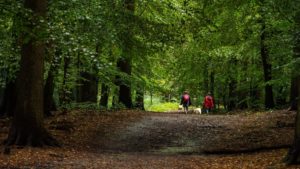Why our kids need forests for true learning
Posted: November 13, 2017Source: Market Watch By LINDAÅKESON MCGURK
What if there were a better way to do early childhood education?

Are kids better off running through the trees than being stuck inside a classroom all day? ZumaPress
It’s a common complaint among teachers as well as parents in the U.S. these days: kindergarten has become the new first grade and the unintended casualty of that is preschool, which has consequently become the new kindergarten. Many early childhood experts consider physical activity and unstructured play the two main pillars for learning and a healthy development for preschoolers. Both are often lacking at American preschools, where play is typically directed by the adults and the students are more likely to be found cooped up indoors, filling out worksheets and tracing letters. Not to mention kindergarten, where students are expected to sit still at their desks for the majority of the day.
But what if there were a better way to do early childhood education? What if there were a preschool and kindergarten model that let children spend most of the day outdoors, wading in creeks, climbing trees, chasing bugs and making toys out of sticks? What if this type of preschool could revolutionize the way Americans think about early learning? Enter the Scandinavian forest school.
The terms forest school, nature-based preschool, forest kindergarten, outdoor preschool and nature school are often used interchangeably in the U.S. to describe a type of schooling that revolves around getting young children outside and interacting hands-on with nature. Although still a novelty in North America, these alternative preschool forms have been around since the 1950s in Scandinavia and are today popular across Europe. Germany alone has over 1,500 so called waldkindergartens, or forest kindergartens.
At the original Scandinavian forest schools, which also function as daycare centers, the children can stay part- or full-time and they spend most of the day outside – rain or shine. The teachers at forest schools consider themselves “co-discoverers” who simply kindle the children’s innate ability to learn by gently guiding them. The curriculum is focused not on teaching academic skills but to help children develop essential physical, emotional, social and personal skills through free play in nature. A typical day at forest school the children may build den under a tree, investigate animal scats, help start a fire and eat lunch in the forest. If this doesn’t sound like enough to prepare a young child for life, consider these five examples of the many ways children at forest schools benefit from their outdoor learning environment:
They are more physically active
During forest school sessions, both boys and girls are significantly more physically active than they are at regular school, and their activity is both more intense and more prolonged. Physical activity from outdoor play can in turn contribute to slimmer waist lines and better motor skills.
They play more imaginatively
Nature is the perfect setting for dramatic play and abounds with open-ended play materials like pine cones, rocks, sticks, logs, sand and leaves that encourage children’s imaginations to run wild. These creative skills are essential for problem-solving and succeeding at school and life later.
They don’t fidget
At forest school, active children are easily able to burn off excess energy, which can be particularly beneficial to children with ADHD. Researchers have also found that nature has a soothing, restorative effect that makes it easier for children to focus in a natural area or after spending time in one. And the more natural the area, the stronger the effect.
They become better at judging risk
Children who are allowed to take risks in nature, for example by climbing trees, using tools and being near fire, naturally learn how to manage those risks. Risky play is also believed to nurture adventurousness and cultivate resilience and self-reliance, both traits that can help children overcome challenges.
They develop a desire to protect nature
Children who spend time in nature have a better understanding of how it works and become emotionally attached to it. Several researchers have showed that this makes them more likely to want to protect nature later in life.
